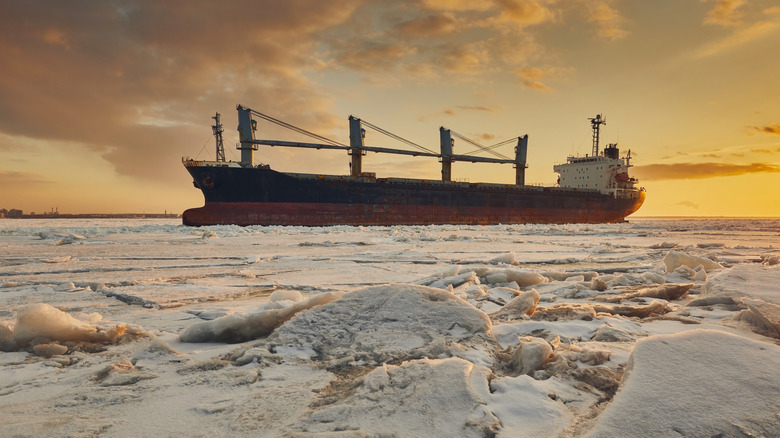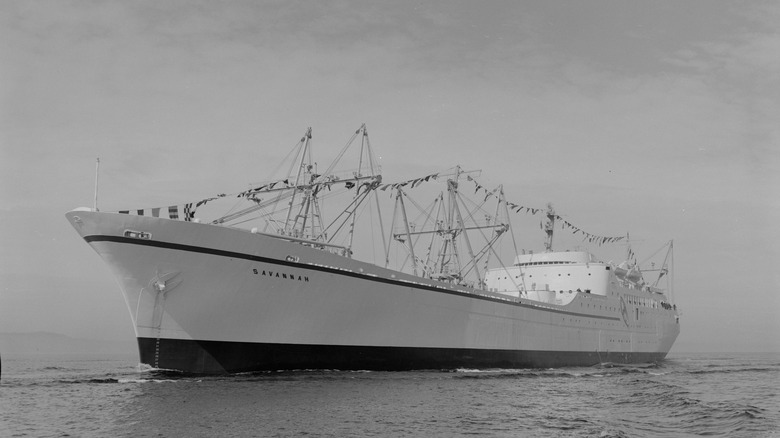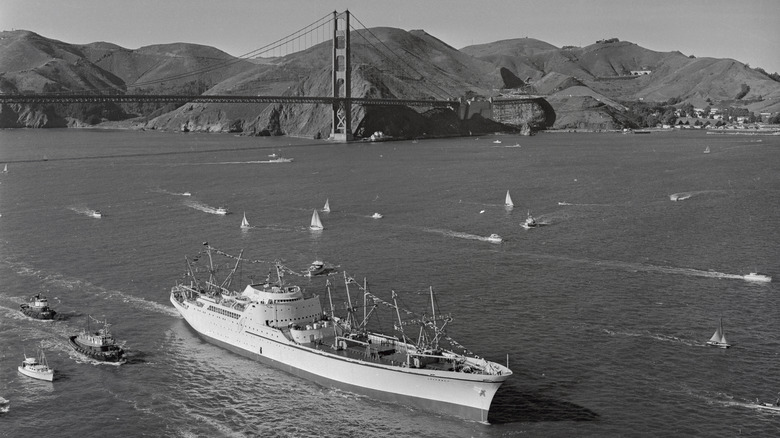Do Civilian Nuclear-Powered Ships Exist?
Since the U.S. military developed the first nuclear marine propulsion system in the 1940s, atomic power has played a critical role in extending the range and sea time of vessels. Starting with 1954's USS Nautilus — a military submarine that, beyond being the first nuclear sub, also made an incredible trip to the North Pole — nuclear-powered vessels have become a staple of six military fleets, namely the United States, France, Russia, China, the United Kingdom, and India. Australia hopes to become the seventh by buying three nuclear submarines for its Royal Navy sometime in the 2030s. To date, over 160 ships are powered by nuclear propulsion. Most are submarines, but select icebreakers and aircraft carriers also utilize atomic power.
Interest in nuclear propulsion goes beyond military vessels, however. For years, proponents have touted a move toward nuclear-powered commercial ships as a potential game changer for the international shipping industry. Not only could the technology drastically reduce the industry's carbon dioxide emissions, but it could also radically reduce cargo ships' refueling needs — a major issue for operators of large cargo vessels. For instance, U.S. nuclear aircraft carriers refuel every 25 years or so. With these distinct advantages, why isn't nuclear propulsion more prevalent in the civil shipping sector? And could recent developments point to this no longer being the case?
The history of nuclear-powered shipping
It may surprise you that the merchant shipping industry's history with nuclear propulsion dates to the late 1950s, when President Eisenhower sought to quell concerns over the escalating nuclear arms race by demonstrating how atomic power could be applied to civilian purposes. Initiated after his Atoms for Peace speech in 1953, the NS Savannah was the first civilian merchant ship powered by a nuclear propulsion system. President Eisenhower hoped the NS Savannah could serve a dual purpose, roaming the seas as a "peace ship" passenger vessel while proving the technical viability of atomically powered vessels as a cargo ship.
Powered by a 74-megawatt pressurized water reactor, the 22,000-ton vessel used low-enriched uranium to heat the water into steam that would power its turbines and provide electricity. This propulsion system could reach 20 knots and could travel 454,000 miles without refueling — a distance that, according to NPR, would've required 28 million gallons of traditional fuel.
Despite its technical success, the NS Savannah was an economic failure. Built more to satisfy technical and diplomatic agendas than fulfill its economic obligations, the nuclear ship could only carry 60 passengers at a time, while its cargo capacity was only 8,500 tons, far less than its competitors. After 26 countries and half a million miles, the NS Savannah retired.
Only three other nuclear-powered merchant ships were ever constructed: Germany's Otto Hahn ore carrier, Japan's Mutsu cargo ship, and Russia's icebreaker Sevmorput.
Why nuclear shipping failed
So why did nuclear propulsion fail in the commercial market? The answer comes down to two factors: costs and safety. Despite the fuel savings, the upfront costs of manufacturing uranium-powered engines far exceeded those of their diesel counterparts. Nuclear ships also require additional port infrastructure to refuel and dispose of their fuel. Maintenance and additional operational costs were also a major financial hurdle. From 1965 to 1969, the NS Savannah cost roughly $2 million more annually than its diesel competitors — about $18.8 million in today's currency.
This was, in part, due to the complexity of its systems, which required the vessel to provide additional nuclear training for its crew and onshore staff, as well as necessitating a costly nuclear ship-servicing facility. Because the NS Savannah's dual-purpose design made it impossible to make up for these additional costs, the ship couldn't prove to potential investors that the long-term financial fuel and efficiency gains were worth the prohibitive startup costs.
Environmental dangers were also a limiting factor for the future of commercial nuclear propulsion. Japan's Mutsu cargo freighter made headlines when its faulty reactor shield leaked radioactive material 500 miles into its native voyage in 1974. The NS Savannah, for its part, dumped 115,000 gallons of low-level radioactive waste during its first year of operation at sea after it exceeded its initial storage capacity. Concerns over the potential nuclear disasters caused Germany's NS Otto Hahn and Russia's Sevmorput to be banned from multiple ports.
The future of nuclear shipping
Today, Russia's Sevmorput is the only nuclear-powered merchant ship still in service. For 36 years, the icebreaker has shepherded cargo and vessels through Russia's Northern Arctic, where fueling challenges and extraordinary power demands make nuclear propulsion systems a top priority. Following this success, Rosatom, Russia's state-owned atomic corporation, developed a fleet of atomic-powered icebreakers — one the Kremlin hopes to expand to 17 vessels in hopes of cementing its hold on the Northern Sea's trade routes and resources. However, the Sevmorput won't be a part of Russia's plans much longer, as Rosatom announced it will retire the nuclear vessel.
Despite Sevmorput's fate, recent developments attest to the possible reemergence of the technology. In February 2025, for example, HD Korea Shipbuilding & Offshore Engineering revealed plans to develop a small nuclear reactor cargo ship. Although it hasn't announced its production timeline, the company hopes to develop a business model by 2030. The Norwegian-led consortium NuProShip also hopes to build a prototype by that time. In 2023, China revealed its plans to construct a thorium molten salt reactor-powered cargo ship that promises to be the largest ever built.
Despite these developments, several obstacles remain. For one thing, companies must navigate a complex regulatory environment. Insurance could also limit profitability, as nuclear power plants typically command $500 million annually in insurance costs. Assuaging the safety concerns of both nation-states and the public is a key challenge, as several nations won't accept nuclear ships. But despite these obstacles, proponents are confident that nuclear-powered shipping is within reach.



